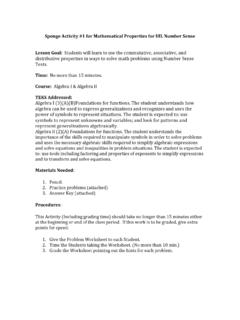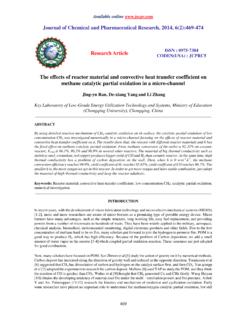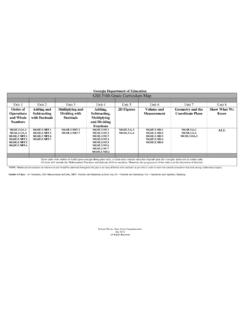Transcription of An Industrial i-Butane/n-Butane Fractionator
1 An Industrial i- butane /n- butane Fractionator Klemola and Ilme [Ind. Eng. Chem., 35, 4579 (1996)] and Ilme [ Thesis, University of Lapeenranta, Finland (1997)] report data from an Industrial i- butane /n- butane Fractionator that is used here as the basis for this case study. The column has 74 valve trays, the feed was introduced onto tray 37. The key design parameters for the valve trays are given in the table below. Column Height Downcomer Area (center) m2. Column Diameter Tray Spacing Number of Trays 74 Hole Diameter 39mm Weir Length (side) Total Hole Area m2. Weir Length (center) Outlet Weir Height 51mm Liquid Flowpath Length per pass Tray Thickness 2mm 2. Active Area m Number of Valves per Tray 772. 2. Downcomer Area (side) m Free Fractional Hole Area The measured compositions and flow rates of the feed and products for the C4 splitter are summarized in the table below.
2 Measured Feed and Product Flows and Compositions (mass %). for i- butane /n- butane Fractionator (Ilme, 1997). Species Feed Top Bottom Propane Isobutane n- butane C4 olefins Neopentane Isopentane n-Pentane Total flow (kg/h) 26234 8011 17887. Other measured parameters are as follows: Other details of the i- butane /n- butane Fractionator Reflux Flow Rate kg/h 92838. Reflux Temperature C Column Top Pressure kPa Pressure drop per tray kPa Feed Pressure kPa Boiler Duty MW Rarely, and this is a case in point, are plant data in exact material balance and it will be necessary to reconcile errors in such measurements before continuing. The feed and product compositions as adjusted by Ilme so that they satisfy material balance constraints, are provided below.
3 Note how the C4 olefins are assigned to isobutene and 1-butene. Adjusted feed and product compositions (mass %) and flows for i- butane /n- butane Fractionator (Ilme, 1997). Species Feed Top Bottom Propane Isobutane n- butane Isobutene 1-butene Neopentane Isopentane n-Pentane Total flow (kg/h) 26122 8123 17999. To proceed with building a model of this column we specify the number of stages equal to the number of trays plus condenser and reboiler (N = 76). The common arrangement of locating the actual feed between stages may need modeling as two separate feeds; the liquid portion to the stage below and the vapor portion to the stage above. In this particular illustration the feed is (assumed to be) saturated liquid and we provide just a single feed to stage 38.
4 Upon computing the bubble point of the overhead product we will find that the measured reflux temperature is well below the estimated boiling point. Thus, we choose the subcooled condenser model. The steady-state concept of the so-called sub-cooled condenser often does not exist in practice. Instead, the condenser is in vapor-liquid equilibrium with the vapor augmented by a blanket of non-condensable gas (that has the effect of lowering the dew point of the overhead vapor). The sub-cooled condenser is a convenient work around for steady-state models (as is needed here), but not for dynamic models. We assume a partial reboiler. The specifications made to model this column are summarized below: Variable Number Value Number of stages 1 N = 76.
5 Feed stage location 1 39. Component flows in feed c=8 See other table Feed pressure 1 120 psia Feed vapor fraction 1 0. Pressure at the top of the column 1 kPa Pressure drop per stage N 1 = 75 kPa Heat duty on each stage except reboilers and condensers N - 2 = 74 Qj = 0. Reflux ratio (replaces heat duty of condenser) 1 R = Bottoms flow rate (replaces heat duty of reboiler) 1 B = 17999 kg/h Temperature of reflux 1 K. Total 165. Finally, we must select appropriate methods of estimating thermodynamic properties. Ilme (1997) used the SRK equation of state to model this column, whereas Klemola and Ilme (1996). had earlier used the UNIFAC model for liquid phase activity coefficients, the Antoine equation for vapor pressures and the SRK equation for vapor phase fugacities only.
6 For this exercise we used the Peng-Robinson equation of state. Computed product compositions and flow rates are shown in the table below. Specified feed (Ilme, 1997) and computed product compositions (mass %) and flows for i- butane /n- butane Fractionator Compound Feed Top Bottom Propane Isobutane n- butane Isobutene 1-butene Neopentane Isopentane n-Pentane Total flow (kg/h) 26122 17999. The agreement with the adjusted material balance (tabulated above) appears to be quite good and to a first approximation it seems that we have a good model of the column. It must be noted that although this column is distilling a mixture containing at least 8 identifiable compounds, only two are present in significant amounts and, therefore, this is essentially a binary separation.
7 It is usually relatively straightforward to match product compositions in processes involving only two different species simply by adjusting the number of equilibrium stages. We shall return to this point later. It is possible to estimate the overall efficiency for a column such as this one simply by adjusting the number of equilibrium stages in each section of the column that are needed to match the mass fractions of i- butane in the distillate and n- butane in the bottoms. Using the SRK equation of state for estimating thermodynamic properties Ilme (1997) found that 82 equilibrium stages (plus condenser and reboiler) and the feed to stage 38 were required. This corresponds to an overall column efficiency of 82/74 = 111%.
8 Klemola & Ilme (1996) used the UNIFAC model for liquid phase activity coefficients, the Antoine equation for vapor pressures and the SRK equation for vapor phase fugacities only and found that 88 ideal stages were needed; this corresponding to an overall efficiency of 119%. With the Peng-Robinson equation of state for the estimation of thermodynamic properties we find that 84 stages are needed (while maintaining the feed to the center stage as is the case here); the overall column efficiency for this model being 114%. The differences between these efficiencies are not large in this case, but the important point here is that efficiencies all types depend on the choice of model used to estimate thermodynamic properties.
9 Caution must, therefore, be exercised when using efficiencies determined in this way to predict column performance. As an alternative to varying the number of stages we may prefer to maintain a one-to-one correspondence between the number of stages and the number of actual trays, 74 in this case (plus condenser and reboiler), with the feed to tray 38. Using the Peng-Robinson equation of state and a Murphree stage efficiency of 116% we find the product mass fractions that are in excellent agreement with the plant data. The McCabe-Thiele diagram for this case, assembled from the results of the simulation, is shown below McCabe-Thiele diagram for Isobutane - n- butane 1. Y Isobutane/(Isobutane+n- butane ). 39. 0 ChemSep 0 1.
10 X Isobutane/(Isobutane+n- butane ). McCabe-Thiele diagram for C4 splitter Composition profiles computed from this model are shown below. Note that the mole fractions are shown on a logarithmic axis so that all of the composition profiles can easily be seen. 20. Stage 40. 60. 1e-05 1. Liquid phase mole fraction X Propane X Isobutene X Isopentane X Isobutane X 1-butene X n-Pentane X n- butane X Neopentane Liquid phase mole fraction profiles for i- butane /n- butane Fractionator It must be remembered that this is essentially a binary separation and that it is usually relatively straightforward to match product compositions in processes involving only two different species. In other cases involving a greater number of species with significant concentrations it will likely be necessary to vary both the number of stages and the component efficiencies to match plant data.






